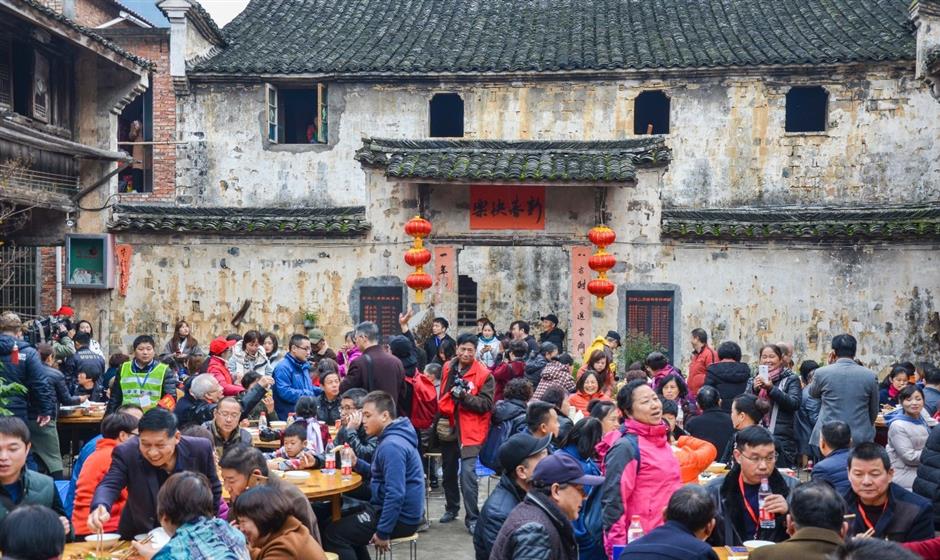

Hangzhou has spent more than 10 years renovating around 2,000 historical buildings across its rural areas and counties. Architecture from ancestral halls and temples to old residential complexes were given a facelift according to their original appearance and layout. The buildings are seen as a valuable part of Hangzhou heritage and represent the glory days of the past and the wisdom of the city’s ancestors.
An online vote is currently underway on the official Hangzhou government WeChat account to select the city’s most impressive ancient countryside buildings. Residents and visitors have until September 9 to vote.
Shanghai Daily sent a roving reporter down to have a look around the city and picked out a couple of rejuvenated structures with historical and cultural value.

Youxu Hall
Youxu Hall 攸叙堂
The hall is located in Shen’ao Town, which could date back to the Song Dynasty (960-1279). When the Shentu family settled here, they laid the foundations of a drainage system that comprised of natural creeks, ponds, ditches, wells and canals. The system takes full use of surface and underground water, separating drinking water and sewage while solving the problem of flooding. It is still in use today.
More than 140 ancient houses were built on the drainage system and designed as quadrangle dwellings, with each courtyard linked to the next through side doors.
The hall is the highlight of the complex. It is in a traditional Hui style and some parts epitomize classical Chinese wood carving techniques. These are reflected in the sophisticated sculptures seen on the beams, rafters, upturned eaves and furniture.
According to historic archives, it took the family more than 10 years to complete the construction. In ancient times, it was used to worship ancestors and pray for thriving offspring.
In 2012, local authorities invested more than 1.4 million yuan (US$214,000) to revamp the ancestral hall. Today, it is still a get-together spot for the Shentu family during festivals and celebration ceremonies. It also attracts many visitors interested in ancient architecture.

Zhong Family Mansion
Zhong Family Mansion 钟氏大屋
The Zhong Family Mansion is a large, well-preserved traditional Hangzhou-style complex built by the Zhong family ancestors. The Zhong family has dwelled in Yinkeng Village ever since they relocated from Jiangsu Province in the Han Dynasty (206 BC-AD 220).
The village witnessed turbulence throughout the dynasties because it was a vital military location at the intersection of the Fuyang, Tonglu and Pujiang counties. Though several other parts of the village were ravaged and ruined by war, the mansion survived.
It has 200 rooms and covers nearly 6,000 square meters, and there are around 300 members of the Zhong clan still living in the enormous mansion. They live a traditional Chinese lifestyle, adhere to family rules and share happiness and sorrow with each other.
Like other traditional architecture, the mansion was constructed according to fengshui concepts. The structure has hills to its north and water to the south. To protect against fire, the building has wells and a drainage system in its enclosed patios.
The mansion includes a couple of halls with different functions. Some were used in wedding and worshipping ceremonies, while some are for funerals and collective activities.

Dongziguan Village
Yueshi Temple 越石庙
The temple is situated in Dongziguan Village, near the border of Fuyang and Tonglu. For centuries, it has attracted streams of devout incense burners from the area, and it still plays a role in local religious ceremonies today.
Dongziguan, which literally means “eastward catalpa trees at the pass” in Chinese, owes its name to a legend, which says a group of catalpa trees sprang up around a Song Dynasty official’s grave on Ziwei Hill.
Nowadays, only the Yueshi Temple stands on the hill. It dates back to the Qing Dynasty (1644-1911) and is dedicated to the God of Earth. Over the centuries, the temple fell into ruin and was restored numerous times. Today, it is a protected site in Fuyang District.
Yu Dafu, a noted modern Chinese short story writer and poet, spread the village’s fame. In a novel of the same name, Yu wrote about the village’s idyllic landscapes. Two years ago, the village became a sensation on social media after the residential buildings were revamped and featured geometric beauty inspired by the great painter Wu Guanzhong.

 Award-winning photos show poverty reduction achievements in NE China's Jilin province
Award-winning photos show poverty reduction achievements in NE China's Jilin province People dance to greet advent of New Year in Ameiqituo Town, Guizhou
People dance to greet advent of New Year in Ameiqituo Town, Guizhou Fire brigade in Shanghai holds group wedding
Fire brigade in Shanghai holds group wedding Tourists enjoy ice sculptures in Datan Town, north China
Tourists enjoy ice sculptures in Datan Town, north China Sunset scenery of Dayan Pagoda in Xi'an
Sunset scenery of Dayan Pagoda in Xi'an Tourists have fun at scenic spot in Nanlong Town, NW China
Tourists have fun at scenic spot in Nanlong Town, NW China Harbin attracts tourists by making best use of ice in winter
Harbin attracts tourists by making best use of ice in winter In pics: FIS Alpine Ski Women's World Cup Slalom
In pics: FIS Alpine Ski Women's World Cup Slalom Black-necked cranes rest at reservoir in Lhunzhub County, Lhasa
Black-necked cranes rest at reservoir in Lhunzhub County, Lhasa China's FAST telescope will be available to foreign scientists in April
China's FAST telescope will be available to foreign scientists in April